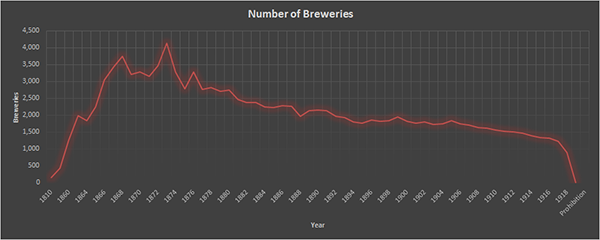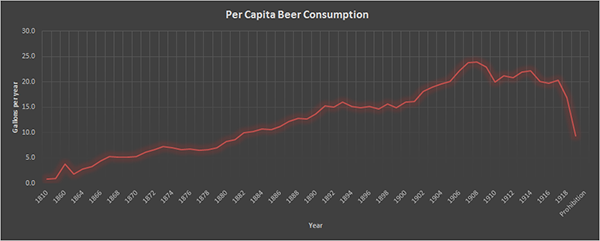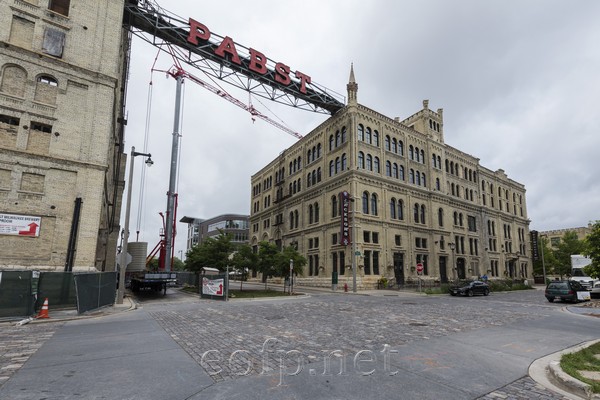Introduction: American Brewers' Review 1898 Brewers' Guide
This introduces four articles that focus on the American Brewers' Review 1898 Brewers' Guide.
Part 1. An overview of the Brewers' Guide with production figures mapped
Part 2. A discussion of the types of beer brewed in 1898
Part 3. A brief discussion of bottling, malting, saloons and depots
Part 4: Germans in the brewing industry in 1898

Crockery City Brewery, East Liverpool Ohio
My interest in pre-prohibition breweries was initially sparked by the way the buildings look. They can be towering structures. They are often relatively windowless, extravagantly ornamented, and hulking. They are relatively rare gems of Victorian industrial architecture scattered through the post-industrial neighborhoods of America. But what kept my interest over the years is the pre-prohibition brewery’s usefulness for gauging how cities evolve. They are useful indicators of how the industrial landscape of the United States developed in the 19th century. Because of their distribution, they are useful indicators of how industrial buildings, in general, have been reused or demolished once their design purpose has ended. Their general distribution, and the fact that they were all closed in the same year, 100 years ago, makes them uniquely well-suited subjects for study. The remnants of those brewery structures have been the primary focus of my research for the past few years. I’ve felt that it was necessary, though, to understand the history of the pre-prohibition brewing industry in order to understand the material remains of it. In an effort to move this project towards some sort of completion, I will be posting bits and pieces, in no particular order, of the results of my research here.
100 years ago, at the end of 1919, an entire industry was shut down in the United States by the enactment of national prohibition. The brewing industry employed 75,404 people in 1914, the year of the last economic census before the impacts of the Volstead Act. This was in a much smaller economy and nation than we have today. About 1,300 breweries were widely distributed throughout the urban landscape of the US. Almost every city with more than 10,000 inhabitants (374 of them in 1910) had at least one. Larger cities like Philadelphia, New York and Chicago had dozens of breweries. The brewing industry grew to its’ large size in a relatively short period of time. Prior to the Civil War, beer brewing in the US had mostly taken place in homes, taverns or small pre-industrial breweries. After the 1860s, the brewing industry rapidly grew and industrialized. The industry first went through a proliferation stage with the number of breweries increasing from 431 in 1850 to 4,131 in 1873. The industry then consolidated and industrialized. The output of breweries grew from 9,633,323 (31 gallon) barrels in 1873, to 66,105,445 barrels in 1914. During the same period the number of breweries declined from 4,131 to 1,392. It was during this consolidation phase that monumental industrial breweries were built throughout urban America.
The industrial pre-prohibition brewery was a temporally concentrated phenomenon. Most were built in the thirty years from 1880 to 1910. The earlier exceptions were almost exclusively in the largest northeastern cities. From the 1880s on, due in part to the invention of mechanical refrigeration, large breweries were built in almost every industrializing town or city in the country. Beer was bulky; it spoiled easily, and was difficult to ship on 19th century transportation networks. Beer was brewed close to market and was a fundamentally local product. Every town had a local brand, or several, and every city had one or more hulking, multi-story breweries in its skyline. These structures were the product of a cultural flourishing unique to the United States. They borrowed technology from Europe and towards the end of the 19th century were built and owned almost exclusively by German immigrants. But they were designed and operated in uniquely American ways. That brief period of culture production ended between the outbreak of WWI in 1914 and the enactment of national prohibition in 1919. The temperance movement, anti-German sentiment, and general xenophobia combined to help speed the 18th Amendment's passage. The political system of the country at both state and federal levels favored rural voters over urban. Then as today, anti-urban and anti-immigrant sentiment swept the rural districts of the country. The disproportionate political influence of those districts made national prohibition possible in spite of the fact that it was opposed in most urban areas. The 13 years of national prohibition destroyed the brewing industry. When prohibition was repealed in 1933 the legal and economic environment had changed radically. Most of the breweries that did manage to reopen in 1933 had closed again by the 1940s and 50s. By 1978 only 89 brewing companies remained in business. Since the 1980s, brewing has been experiencing a re-localization. There are now more breweries operating in the US than at any point in history. Brewing is a fascinating example of an industry transitioning from local, to national mass-market, and now back again to local. I have not made any attempt to study the post prohibition history of brewing though.

Click image for larger version.
The following series of four articles focus on the state of the brewing industry in 1898. I will follow with a similar set of articles on the industry in 1878-1879. These years were more or less chosen for me by the fact that I’ve found useful surveys of the industry published in those years. I will also write up and post the results of a comparison between the breweries mentioned in a directory published in 1915 and the extant material remains of the breweries I’ve located. There are a number of related subjects I’d like to write about including; the history of the United Brewery Workers, the gendered space of Victorian alcohol production and consumption, and the post prohibition lives of a number of brewery buildings.
The year1898 was in the middle of the brewing industry’s pre-prohibition industrial period. The brewing industry rapidly expanded after the Civil War. The United States had previously been a nation of hard liquor and cider drinkers. The reasons people switched to beer after the Civil War have never been satisfactorily been explained to me. Many authors attribute the switch to the masses of German immigrants that came after 1848. But the United States was colonized by people who traditionally drank beer, the British, in just as large of quantities as the Germans. Germans never constituted a high enough percentage of total immigration to change the drinking habits of an entire nation on their own. There is, however, a relationship between the waves of German immigration in the mid-19th Century and the proliferation of breweries and beer drinking in the US.
The establishment of breweries is closely related to other kinds of industrial development. Brewing location was never dependent on resource location the way that steel or other resource hungry industries was. It was never dependent on fixed sources of power the way that the textile industry was when it grew along rivers and streams. It wasn’t dependent on sources of cheap labor either. Brewing largely occurred near markets for beer in the 19th century. A market for beer at that time seems to have been any concentration of industrial workers. Breweries were built in almost every factory town. They were also built in every mining town of any size. They were not built, very often, in agricultural trading hubs with the exception of the northern Midwest. Nor were they always features of political centers. Breweries certainly existed in cities with large German populations but they were built, often by Germans, in cities without substantial numbers of German immigrants. The production of beer in cities in 1898 was very strongly correlated to the population of those cities. The amount of beer shipped a significant distance from where it was produced was still very small.
Mechanical refrigeration systems were marketed beginning in the 1880s. By 1898 the brewing industry had universally adopted mechanical refrigeration and stopped using natural ice for cooling. This was especially significant in the production of lagers. Mechanical refrigeration permitted the expansion of the industry into the south for the first time. But the only places in the south where it had grown to any substantial size by 1898 were the few industrialized cities like New Orleans and Richmond. The vast majority of beer sold in 1898 was sold directly to saloons in wooden barrels or kegs. Many breweries had exclusive arrangements with saloons or owned saloons directly. Beer sold for home consumption was still poured into buckets or whatever receptacle a customer might have. The market for bottled beer was growing though. Beer pasteurization which dramatically increased the shelf life of bottled beer had been introduced in the 1880s and was gaining popularity. Automatic bottling machines had been invented that reduced the price of bottled beer. Bottled beer was still a premium product though. Half of the breweries listed in the 1898 Brewers' Directory had bottling operations of some size. Lager had been gaining market share from ales and porter since it was introduced in the 1840s. In 1898 around three quarters of the beer produced in the US was produced in breweries that only made lagers. Brewing had become an economic niche for German immigrants by 1898. Except in the Northeast, Germans both owned and constituted the labor force of the majority of the nation’s breweries. The specter of prohibition still seemed like a distant threat in 1898 to most brewers. Brewery owners were investing in new plants and new industrial equipment. Trade journals from that year are full of advertisements for bottling machines, pasteurizers, refrigeration machines, pneumatic malters, steam jacketed brew kettles and more of the latest inventions. Advances in the understanding of the brewing process and newly invented industrial brewing equipment led to rapid increases in the size and output of the largest breweries. In 1898, 47,105 people were engaged in the brewing industry as brewery workers, managers and owners. The largest brewery in the country was Pabst in Milwaukee which produced close to a million barrels that year. New York state led the nation in total production with its’ breweries producing over 10 million barrels.
Part of the Pabst Brewery in Milwaukee which was the largest in the country in 1898. It is currently used as a hotel and restaurant.
Part 1. An overview of the Brewers' Guide with production figures mapped
All content on these pages Copyright Mark Hedlund 2012-2019. All rights reserved. Use in school projects and with links on social media is always okay. Please send me an email to request permission for any other use: hedlunch@yahoo.com Non-exclusive commercial publication rights for most photos is $25 per image.



